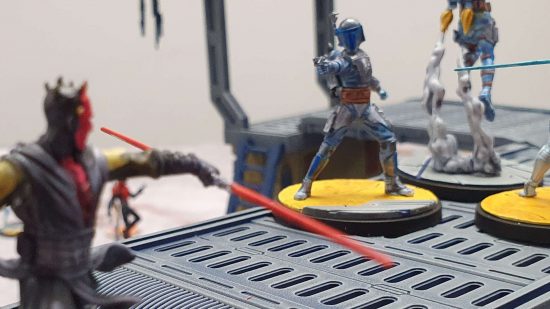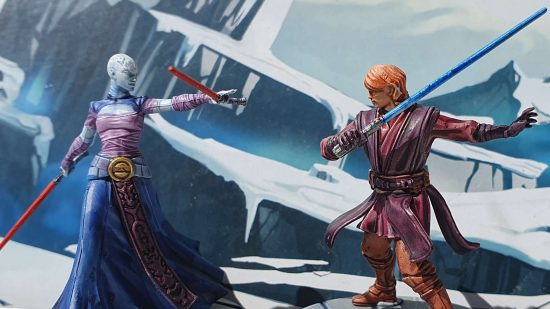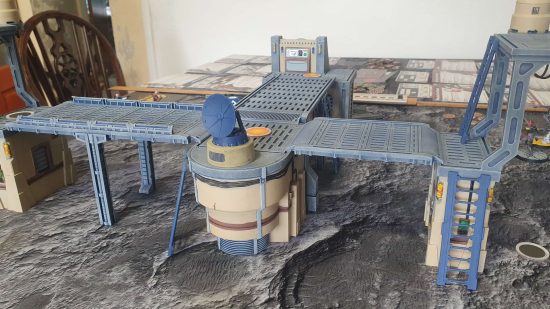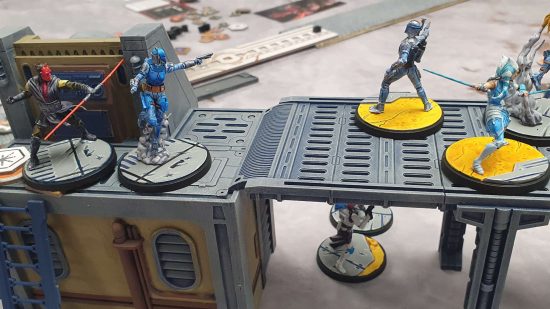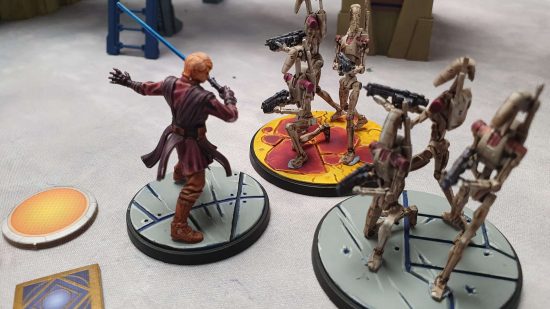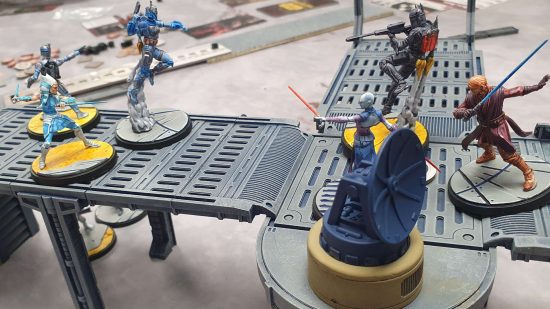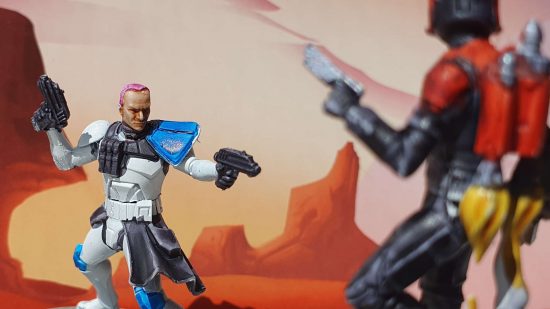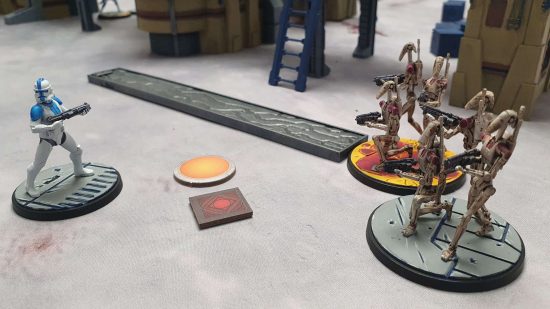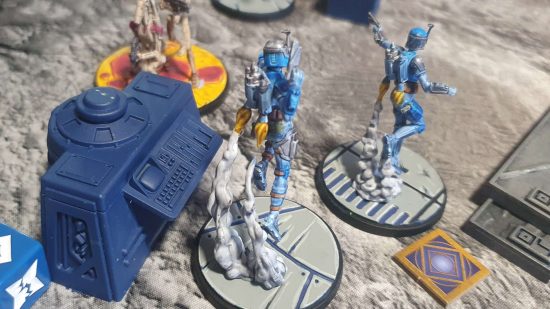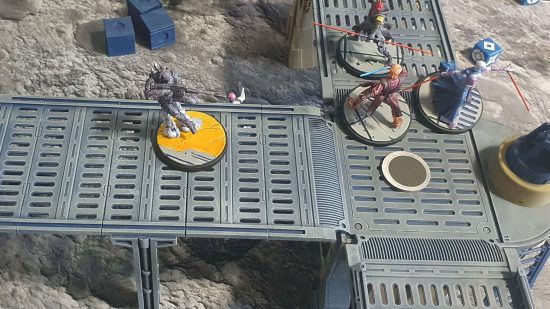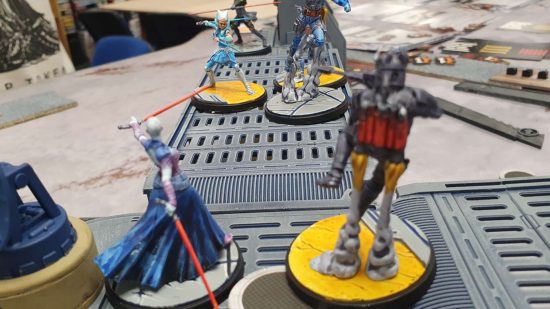Star Wars Shatterpoint is a character-focused skirmish wargame, with an aesthetic similar to the Clone Wars cartoon version of the Star Wars IP. The latest creation from Atomic Mass Games (AMG), Shatterpoint is a mixture of skirmish wargame staples and truly distinctive new ideas.
But does it need to exist? Atomic Mass Games already makes a great Star Wars wargame, Star Wars: Legion, and a brilliant character-focused skirmish wargame, Marvel Crisis protocol. The core set is packed with expensive terrain, with a retail price close to our estimates for the upcoming Warhammer 40k 10th edition Leviathan launch set. And as a D6 and tape-measure lover at heart, I’m immediately suspicious of Shatterpoint’s custom dice and measuring sticks.
This Star Wars: Shatterpoint core set review looks at everything in the box, from widgets to win-conditions, to judge whether Shatterpoint is an elegant wargame for a more civilized age, or just more bantha fodder. A review sample of the core set was provided by Atomic Mass Games.
Star Wars Shatterpoint core set miniatures
The core set comes with all the miniatures you need to play a game of Shatterpoint. There’s four Squads, each consisting of: a Primary Unit, like the Jedi Anakin Skywalker or Sith Darth Maul; a Secondary Unit, such as the Mandalorian Bo-Katan Kryze or Super Tactical Droid Kalani; and a Supporting Unit, such as a pair of 501st Clone Troopers, or two Mandalorian super-commandos.
You’ll build your Fireteam from two Squads. Future Squad Pack expansions will allow you to customise your forces. There’s very few restrictions when building Fireteams: each Squad needs to come from a single point in the Star Wars timeline, and you can’t include two versions of the same, unique individual in the same Fireteam.
The miniature sculpts are excellent. Notionally in 32mm scale, the same as Marvel Crisis Protocol, they seem a little larger than that. Though fairly naturalistic, there’s some aesthetic similarity to the Clone Wars cartoons, with similarly spare details. Compared to all the bling and hyper detailing on miniatures from the Warhammer 40k factions, it’s honestly quite refreshing.
Assembling the miniatures ranges from “fine” to “appalling”. The kits aren’t complex but some are extremely fiddly. The droid models in particular have miniscule limb joins and small parts. I lost one set of droid antennae as they pinged off the sprue, necessitating a putty and plasticard bodge job.
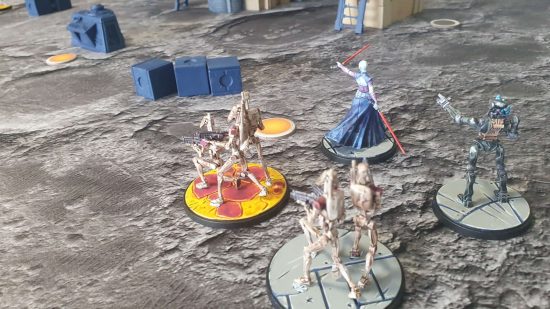
The Jedi and Sith Lightsabers are thin and feel fragile, though they’re a little stronger than they look: I glued Ahsoka Tano’s arms onto the wrong shoulders, pulled them out of her sockets when I spotted the error, and her lightsabers survived.
If building the minis can be a pain, painting is a joy. I used Army Painter Speed Paint 2.0 (provided as a free sample by Army Painter) over a white Stynylrez airbrush primer and was delighted by the results. The models have just the right amount of detail, flat surfaces, and texture for contrast paints to work exceptionally well across most of the models. I plan to use some traditional acrylic paints for miniatures to finish the details, mostly because I enjoyed painting them so much.
Star Wars Shatterpoint core set terrain
More than half of the chunky Shatterpoint core set is packed with sprues for terrain, and a good chunk of the cost can be attributed to it. There’s a couple of solid buildings, a pair of narrow two-storey towers, walkways, ladders, and scatter terrain.
By sheer weight of plastic there’s about as much terrain here as in the command edition Warhammer 40k starter set. The buildings are sturdy, with enough weight in the base that they’re not easily knocked over. Details like cables and panels make the buildings look interesting, but there’s not so much greebling that painting them is a pain. It’s all very usable.
The downloadable instructions for the terrain have some bad errors. I had to batter apart one tower to rebuild it after the instructions led me astray, and the illustrations for another building were simply a random selection of pictures from other kits. That’s an annoyance, but the kits aren’t that hard to put together while ignoring the instructions.
While built to a slightly larger scale than 40k, this terrain would work just fine on a 40k battlefield, particularly if you’re fielding Space Marines. It will work brilliantly for sci-fi skirmish games including Necromunda, Stargrave, or the upcoming The Doomed. If you were picking between GW’s Adeptus Mechanicus terrain and this set, I’d point you at this kit every time.
Stars Wars Shatterpoint gameplay
Shatterpoint is a skirmish game that’s all about controlling objectives. You’ve played that sort of thing before, and it does use plenty of tried-and-true mechanics. When it’s innovative it’s startlingly innovative, and the differences have a massive impact on how the game feels.
Players alternate taking turns, activating one Unit, which – in the case of your Clones, Droids, and Mandalorian mooks – might contain two Characters. Each Unit can use two actions per turn, with standard options like advancing, shoot, climbing, focusing – which improves your next attack, dashing – a shorter move that allows you to exit combat, or taking cover. You can’t use the same action twice in a turn.
Units have special abilities that cost Force Points, draining a limited pool that only refreshes once all your characters have activated. Many units have static abilities, or reactions that can be used in response to some other event like an enemy attacking or a friendly unit being Wounded, and each Primary character gets a unique and powerful Identity ability.
All of that’s par for the course for a character-focused skirmish game – distinct rules give each character its flavour and role in your Fireteam.
The combat rules are something else though. Attacker and defender roll a handful of custom dice, and while there’s a few interesting steps in between, you’re basically subtracting the defender’s successes from the attacker’s hits to find out the number of hits you land. Each of those hits turns into a move the attacker gets to make through a branching Combat Tree.
Some steps on those trees deal damage, and some do other stuff, like pushing your opponent backwards, healing your own character, jumping, inflicting a status effect, repositioning your character, even activating one of your Force powers for free. Your force-sensitive main characters even get a choice of combat trees as they switch between combat stances mid battle.
The thematic fit is great – Star Wars duels aren’t defined by hits and wounds, they’re about backflips, driving an enemy backwards along a walkway, claiming the high ground. Despite so much possibility being hidden inside your dice rolls, the system remains approachable – there’s a plethora of symbols, but barely any maths.
Shatterpoint’s lead designer is Will Shick, who worked on Marvel Crisis Protocol and was part of the team behind Warmachine during his tenure at Privateer Press. In some ways this is exactly the kind of game I expect from him. It’s extremely kinetic, with positioning and the ability to move your own and your opponent’s pieces key to your strategy.
But fate has a big roll to play in Shatterpoint: by nesting some of your abilities inside combat resolution, you’re presented with fresh choices even after you’ve committed to your character’s action for the turn.
You don’t get to control when units activate, either. Each turn you’ll flip over a card from your unit deck, revealing a Unit. You can spend one force point to put a Unit into reserve, and each deck has a ‘Shatterpoint’ wildcard that allows you to activate any unit, but otherwise you’re trusting to the Force.
This randomness is juxtaposed by very tight, very deterministic mission win conditions. The game is split into two or three Struggles, in which certain objectives will be active. To win a Struggle you need to move a Struggle marker to your end of a track you share with your opponent, in a tug of war.
Holding objectives moves the Struggle in your direction, and certain events – like Wounding an enemy character – can shrink the track. Once a Struggle ends you reveal a new objective card, revealing a choice of maps that will activate a different set of objectives; the loser of the current Struggle gets to pick the map for the next.
The choices that unfold from this simple setup are remarkable. Grabbing an objective involves putting more bodies on it than your opponent. Some units are lightning fast, with force powers or Mandalorian Jetpacks, able to traverse most of the board in one turn and grab an undefended objective. Some slippery units have movement abilities that will activate during combat, some can move other allied units outside their turn, or reposition in response to enemy actions.
Alternatively, you can take your opponents’ units off objectives. Wiping a unit out entirely is tricky, but if you can do enough damage to Injure them, they won’t be able to contest an objective until they activate again. Many units can Shove their opponents back during combat, and Force powers might let you drag enemies towards you or yeet them into oblivion.
You have perfect information about how many points you’re going to score at the end of your turn, how many you could score if you can claim an objective – but you don’t know what Unit you’ll get to activate next, you can’t predict what state your opponent will leave the board in after their next turn, and you don’t know what opportunities your own attacks will generate.
Every turn asks you to find the opportunity in the random hand you’re dealt – and if it looks terrible, you can always back off, accept you’re going to lose this Struggle, and position yourself for the next one. You’re managing chaos, and it feels great.
While the mission is abstract – effectively a zone control scenario from your choice of online shooter – the stuff that happens during the game is is dripping in Star Wars theme.
I’ve had Anakin Skywalker batter Darth Maul the length of a walkway, then vault off and onto an objective held by a swarm of battle droids; seen Darth Maul rip Captain Rex off a gantry with the force to shove a Lightsaber down his throat; sent Mandalorians jetboosting out of combat to grab objectives; had B6 battle droids shoot into Anakin Skywalker, only to suffer more damage than they inflicted as he deflected their shots.
Criticisms? The rules could be clearer in parts – the distinction between ‘Characters’ and ‘Units’ is a little bit head achey, the rules for pushing models near the edges of elevated terrain are written in awful legalese, and I’m still not sure I’m playing ‘priority objectives’ right. I haven’t mentioned the rules for vertical terrain – they’re elegant in play, work perfectly for the theme, but in the rulebook they’re a bit of a pain to read.
I’m a pathological Warhammer 40k fan salivating over the looming launch box set for 10th edition, but I have absolutely no qualms recommending Shatterpoint to anyone who has the slightest interest. It’s a great game with everything you need to play in one box. And far from a gimmick, every new idea and bespoke component supports both the theme and the gameplay, elevating them in a way I can only call inspired.
Shatterpoint plays the way that Star Wars looks. No, better than that – it plays the way you remember Star Wars looking. It plays how Star Wars feels.
The force is strong with this one
Star Wars Shatterpoint is one of the best Star Wars experiences you can have on a tabletop, packed with kinetic action, tense gambits, and sudden turns of fate. The models and terrain are top notch, and this core set is packed with everything you need to play.
Source: Wargamer



